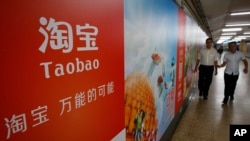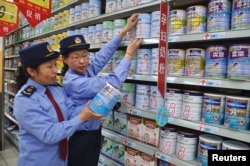China has increased taxes on purchases made through cross-border e-commerce platforms in a bid to recover revenue losses.
The new plan is expected to tighten control over the loosely-regulated market, while ensuring a much fairer tax base and competition between brick-and-mortar importers and cross-border online trade.
But a last-minute revision of the e-commerce product import list late last week caught many operators off guard, leaving them at a loss over how to manage the delivery of goods that are no longer permitted.
No way out
“Some products, which were previously allowed for cross-border online trade are no longer on the list. [Because of that], lots of goods are now stuck in bonded warehouses and can’t be delivered,” said Nick Zhong, head of Guangdong Cross-border E-commerce Industry Association’s member service department.
“Once excluded by the list, neither goods in transit or on board will be admitted into bonded warehouses. That’s another major impact,” he added, conveying concerns expressed by many of the association’s 2,000 e-commerce business members.
Imports such as liquid milk, baby formula, fresh fruits and aquatic food are not covered by the list, which details the scope of 1,142 commodities allowed under the new cross-border e-commerce model.
Liquid milk, which has an expiration date, may be hit the hardest as the association estimated that stockpiles worth more than $15.5 million may be left in limbo if the regulator won’t revise the list soon or come up with a solution to fast-track its delivery, according to Zhong.
On Friday, the finance ministry added 151 more products to the commodity list after taking into suggestions from the private sector. According to the ministry's press release, a grace period will be extended until early 2018 for the delivery of baby formula without registration certificates. However, it is not clear if liquid milk is included on the government's latest list.
The association’s Zhong, nevertheless, is optimistic that authorities will soon address the $15.5 million liquid milk situation or e-commerce operators can always resort to the channel of normal imports to clear their goods though they have to pay due taxes.
Complicated clearance
In addition, the e-commerce sector is already feeling pained from complying with the new clearance system, although Zhong said that it’s just a matter of time for businesses to get used to the new model.
For the first week, it is still too early to tell how the new taxation plan will impact the industry or its overall sales, although competition is sure to get tougher along with price fluctuations triggered by hiked taxes, he said.
Most operators, he added, will watch and wait because big companies have the upper hand with supply-chain logistics and clearance advantages, while small outfits are looking to maintain a profitable niche.
On the consumer side, many still believe that cross-border shopping remains a powerful draw.
“There is still demand for cross-border products. And our survey showed that [the sector’s] consumers are not that price sensitive,” Zhong said.
Hiked taxes
Under the new plan, most cross-border online purchases will be levied a combined consumption and import value-added tax (VAT) at a 30 percent discount, or 11.9 percent. That compares to such deals’ old postage tax of 10 percent with a waiver if the tax was less than 50 yuan ($7.70).
In other words, online cross-border deals, retailed at below 499 yuan ($77.20), used to be duty-free, but are now levied with a VAT of 59.4 yuan.
However, there are also rate cuts for certain products.
For example, cosmetic imports, whose tax rate was 50 percent if the value of purchases exceeded 100 yuan, will now be levied a lower 32.9 percent tax.
A tariff-free cap of 2,000 yuan per transaction and 20,000 yuan for yearly transactions is also set.
“Those [less competitive] individual shopping agents abroad will likely meet a setback by the new business model. But, in the long run, the new policies help ensure the quality of imports and the tractability of their origins with arrangements to facilitate a [sound market] entry system,” said Tomson Tang, vice chairman of Chinese Electronic Commerce Association.
Tang said he expects the new policies to help push forward the sector’s healthy development and curtail logistics and environmental costs as buyers make small purchases to take advantage of tax waivers.
The new plan, moreover, is expected to provide a pricing catalyst, encouraging local producer to improve the quality of their products to compete with slightly pricier imports, said Hu Xingdou, an economics professor at Beijing Institute of Technology.
With the cost of online shopping climbing, sales of local brick-and-mortar stores may see a boost, the professor added.
Nevertheless, the tax hike adds a burden on local consumers, which could adversely affect the country’s slowing economy.
“Chinese consumers have long been shouldering a pretty heavy tax burden. Estimates show that locals here pay a [macro] tax bill of 60 to 65 yuan out of every 100 yuan transaction,” Hu said.
That is higher than the averaged 30 percent tax burden in other countries, the professor added.
According to McKinsey & Co, China's cross-border consumer e-commerce amounted to an estimated 259 billion yuan ($40 billion) in 2015, more than six percent of its total consumer e-commerce, and it’s growing at a rate of more than 50 percent annually.









